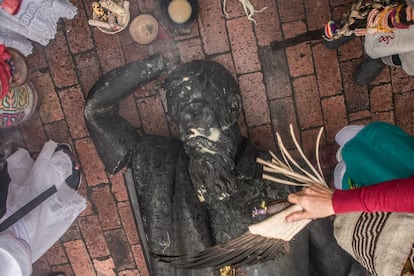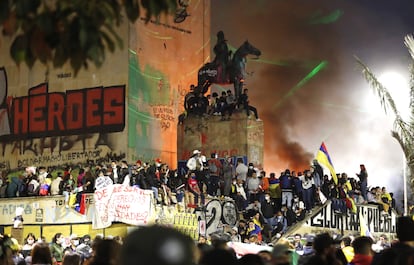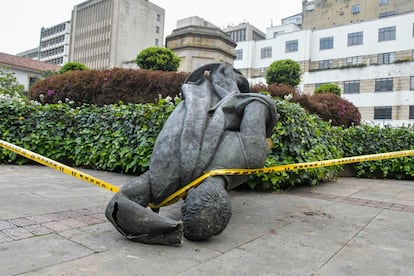Why protesters in Colombia are targeting monuments of Spanish conquistadors
After several statues were toppled, the government of Iván Duque has opened dialogue with indigenous communities and will review the public presence of controversial historical figures that have stood for 100 years


The Monumento a Los Héroes, dedicated to soldiers who fought for independence, is without one of the movement’s most famous figures, Simón Bolivar, astride his horse. The Avenida Eldorado in the Colombian capital of Bogotá is no longer watched over by an early 20th-century statue of explorer Christopher Columbus nor his patron, Queen Isabella I, the Castilian monarch who unified Spain’s kingdoms. The city’s downtown Avenida Jiménez has been renamed Avenida Misak after the Minsk indigenous community. The protests in Colombia have left a string of empty pedestals and an urban landscape attempting to redefine itself.
Following repeated attempts – some of them successful – by protesters and indigenous communities to knock down statues of Spanish conquistadors, among other historical figures, the government of President Iván Duque has removed some and announced a review into other monuments that have stood in the country since 1920. “Our priority is to protect our patrimony. In view of potential incidents, we have decided to move them on a temporary basis to the La Sabana [railway] station,” said Culture Minister Angélica Mayolo. Recently appointed to the post, Mayolo has performed a change of tack on the government’s position concerning monuments. Her two predecessors in the ministry had described the pulling down of statues as vandalism. “The country must respect different viewpoints and listen to indigenous communities who today feel discriminated against by symbols of national heritage, but without condoning violence and destruction,” Mayolo said on announcing the decision of the National Heritage Council to review the presence of several monuments. However, it is not yet clear who will be involved in the dialogue or which are the statues in question.

During the first days of the protests in Colombia, which started on April 28, indigenous protesters toppled a statue of the Spanish conquistador Sebastián de Belalcázar in Cali for a second time. “We have knocked down Sebastián de Belalcázar in memory of our chief Petecuy, who fought against the Spanish crown, so that today we, his grandchildren carry on the fight to change this system of criminal government that does not respect the rights of mother earth,” the Indigenous Authorities of the South West movement said. The same fate later befell a statue of the conquistador Gonzalo Jiménez de Quesada, the founder of Bogotá. Images of his face pressed against the floor and the flags of the Misak indigenous people of Cauca flying on the pedestal were a harbinger of what was to come for monuments across the country. Later that day, a photograph of Dilan Cruz, a young protester killed by the police in 2019, was installed in place of Quesada but during the night a group of people removed it. The Avenida Jiménez, one of Bogotá's busiest thoroughfares, is now known – at least informally – as Avenida Misak, in homage to the indigenous protesters who pulled down the statue.
Following the toppling of the Belalcázar statue, and foreseeing what would happen to similar monuments, the Bogotá District Institute of Cultural Heritage (IDPC) opened up a series of talks over the monuments and what they represent with around 170 people participating. One of the conclusions drawn from the talks is that there is consensus “even among those who have a traditional point of view that it is necessary to broaden the scope of the patrimonial narrative,” and that there should be “no closed-door debates or ones that involve only experts.” “What we have seen during the protests is that there is an interpellation of public space,” explained IDPC director Patrick Morales.

The Misak community has been at the forefront of the tumbling of statues during the protests. On June 10 they gathered around the monuments to Columbus and Queen Isabella I. When they tried to pull the figures down, a squadron of riot police quickly intervened, forming a cordon around the statues and clashing with protesters. Ten people were injured. Although they did not achieve their objective, the protesters remained in place, singing and dancing. The following morning, the government made a surprise decision: the statues were removed. Images of the historical figures laid flat on a huge tow truck in the center of Bogotá, and of the protesters on the vacated pedestals waving flags, were seen by some as a victory for the indigenous communities, although the government stressed it was a preventive measure to protect the statues.
Professor Amada Carolina Pérez of the Social Sciences faculty at the Pontifical Xavierian University explained that the protests are not just a questioning of historical figures, “but of colonialism as a matrix of thought and esthetics.” Pérez agreed with Morales that “this is a telluric movement that is shaking up pubic space” and one that is linked to the graffiti, murals and monuments to resistance that have sprung up during the two months of protests. “This protest has stirred up some very significant things, questioning the way memory has been created in the public space and showing how it could take on a new significance,” Pérez said.
The question now is: what to do with the fallen statues? Where should they be housed? What end should they be given? These are the questions that the roundtables between the authorities and the communities will seek to answer. In Bogotá, where talks are progressing, some proposals have come to light. One is to house them in museums, as other countries have done in the same circumstances. “Take them to museums as backdrops for difficult debates about difficult pasts. It could be an option that, for example, Gonzalo Jiménez de Quesada ends up as an exhibit in one of them. Then, more questions arise. How do we present it? Do we completely retore it or display it with the marks left from when it fell?” asked Morales.
Other options being considered are a public display that would pass through the regions where the historical events occurred to generate debate. Another proposal has been put forward by indigenous groups in Bogotá: to perform ritual burials. This was what happened with the statue of Quesada. On June 20, the winter solstice, the Muisca community gave the Spanish conquistador a funeral procession. The idea, said Morales, was to “let him go and to pardon him, to let the scars heal.” The Muisca explained it like this: “Performing a burial is to ‘cleanse the deceased,’ that is to say paying the spiritual and material debt left behind, healing the history or memory of everything and everybody that was affected. We walk to pay the debt and make sure that history does not repeat itself.”
English version by Rob Train.







































